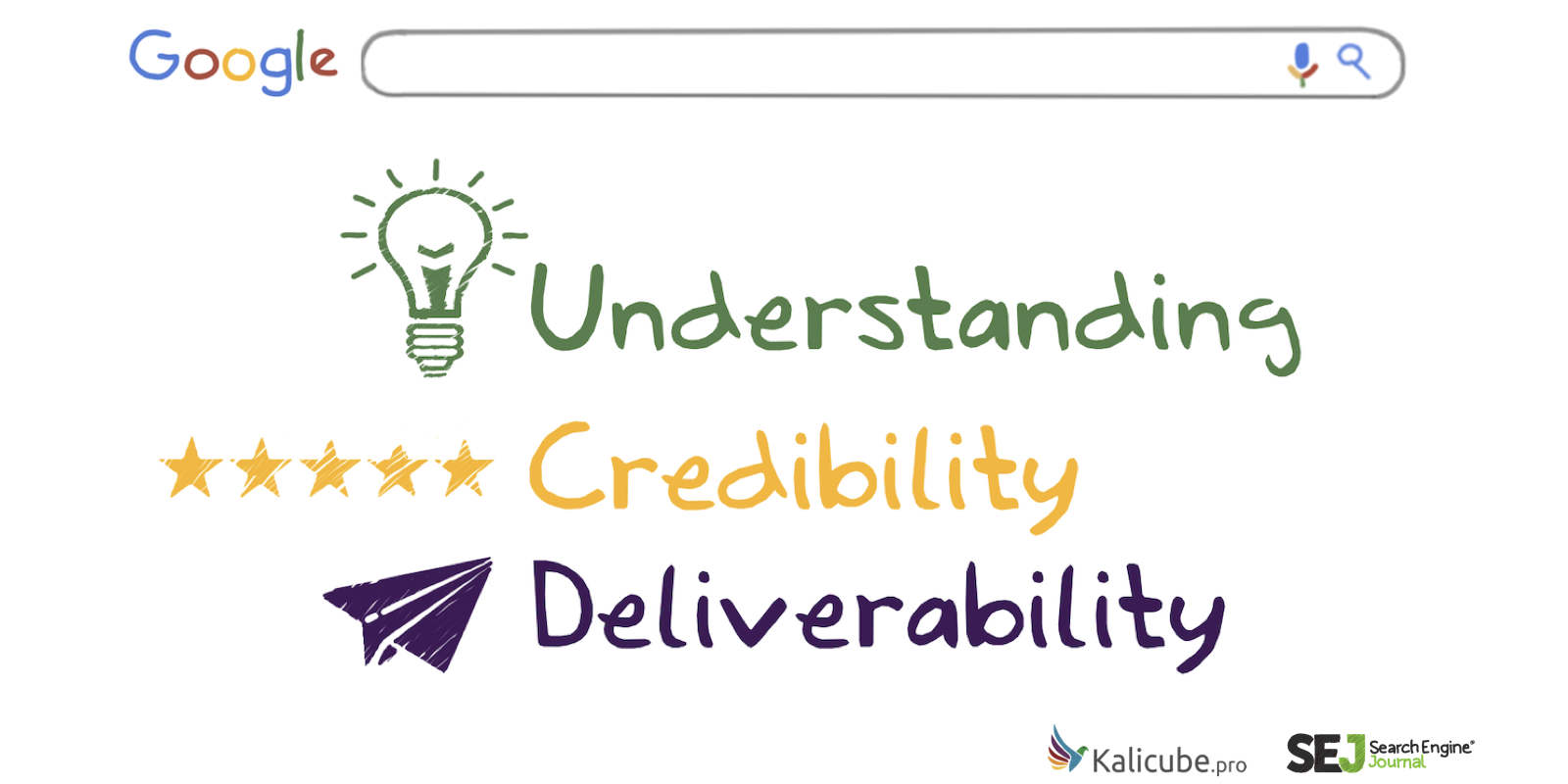Google has three “needs” that we can feed into to win the “modern Google game.”
- Understanding.
- Credibility.
- Deliverability.
That’s it.
Simple.
Everything you do in SEO feeds one or more of these pillars.
If you are doing anything that doesn’t help Google in one of these aspects, it is almost certainly not worth doing.
In this article, you’ll learn a simple, manageable, and delightful approach to our work as digital marketers when it comes to making the most of the opportunities Google offers.
Google’s 3 Needs: Understanding, Credibility & Deliverability
Ever since the beginning, Google’s users have expressed a problem (including asking a question) and Google has sought to provide them with the best solution to their problem (or answer to their question) as efficiently as possible.
Up until Hummingbird, the process was hit-and-miss due to the simplistic manner in which Google ranked the results:
- Counting strings of characters,
- Evaluating links.
- Ranking the results using a human written algorithm.
In hindsight, it’s easy to belittle how Google used to function but it proved to be better than the competition (so much so, it managed to kill off the competition almost entirely).
Manipulating the algorithm was relatively simple.
We all did it to one extent or another.
But in the Hummingbird world, Google got smarter and its algorithm got more complex.
And as the blue link algorithm increasingly took a back seat and an ever-increasing array of rich elements (SERP features) took over, the “SERP game” became increasingly difficult to play.
How do we approach both the algorithms and the SERPs without losing our minds?
My first suggestion is “empathy for the beast” – if we can understand what Google’s problems are, we can better help it to help us.
Understanding
If it is to recommend your content as the solution to its users’ problem (or the answer to their question) Google needs to understand:
- Who you are.
- What you offer.
- What audience you can serve.
Some examples where you can help Google (and Microsoft Bing) understand who you are, what you do, and where you can provide a relevant solution to their user:
- Writing clear, content using semantic triples.
- Creating well-focussed context clouds.
- Adding Schema.org markup to your webpages.
- Including relevant images and videos.
- Structuring your site with well-defined, logical categories.
- … anything that serves to better communicate with a machine.
Googlers and Bingers alike have expressed over and over how fundamentally important relevancy is to them, and how much they focus on getting that right.
So understanding is the foundation.
Without this, the algorithms cannot evaluate relevancy and your content is stuck at the starting gate.
Credibility
Once it has understood that your content offers a relevant solution for its user, then you are in the race.
But it is just that – a race.
Your competitors offer a similar solution, they’ve done everything to help it understand, so you are neck and neck.
Remember that Google wants to provide the best solution to its user when it recommends content.
In a situation where it has clearly understood exactly what your content offers but has also understood your competitors’, it has several options that will solve the user’s problem in a similar manner.
So Google needs to evaluate which one will bring the most satisfaction to the user since its aim is to deliver the best answer to the user as quickly and efficiently as possible (i.e., right at the top of the results).
That is where your credibility and the credibility of your content comes into play.
In Short, Think E-A-T
Some examples where you can convince Google (and Microsoft Bing) that you are the best in the market:
- Clear and convincing pages about your company, your leading employees, authors, partners, clients.
- Accurate and up-to-date content.
- Wide peer-group approval.
- Reviews.
- Positive user comments on your content.
- Anything else that serves to reassure Google that your brand and those associated with your brand are expert, authoritative, and trustworthy within your industry.
- Anything else that supports the credibility of your content (inbound links, social activity, user-generated content on the page, etc.)
Always bear in mind that the credibility (E-A-T in Google-speak) of a given solution (the piece of content) is evaluated at content, brand, and author level.
You need to improve at all three levels.
Deliverability
This seems to me to be the game-changer for anyone still thinking in terms of “traditional” blue link ranking.
In steps 1 and 2, Google has evaluated (and ranked) which of the available options are viable and which are most credible.
But that isn’t enough.
It wants to provide a rich, engaging, and satisfying result for its user.
If we are evaluating 10 blue links, deliverability is purely and simply page speed and mobile-friendliness.
Google is sending the user to your site for the solution to their problem or answer to their question.
But today, with featured snippets, videos, images, local results, and all the other rich elements, deliverability becomes more complex and more important.
This is the game-changer.
As digital marketers, we now have no choice but to look at SEO as part of a wider digital marketing strategy.
You need to create content that is directly valuable for your audience and publish that content on a platform they engage with.
The traditional SEO approach relies heavily on blue links – for Google that is what I would call secondary deliverability (i.e., an evaluation as to whether your site can “deliver” the content as “promised”).
The richer results Google provides today now brings an additional evaluation of deliverability: Google has the choice – does this content provide great deliverability to the user on the site, or on the SERP?
To gain maximum visibility on Google, you need to provide content that can be delivered to your audience on your site post-click but can potentially be delivered to that same user on Google’s SERP.
(The discussion about whether facilitating Google’s capacity to deliver your content on its own results pages is a debate for another day – I really want to focus on a positive and helpful approach to SEO.)
A specific question may be better answered by a video than text (how-to questions, for example), in which case a video is potentially more valuable as a solution to Google’s user – the more “deliverable” solution.
When I mention deliverability, site speed, and mobile-friendly are the knee-jerk, go-to reaction.
Those are both necessary for delivery to the user if they click through to the site.
The more immediate question for Google is three-fold:
- Is the content in the best format for the user (text, tabular data, list, video, audio, infographic)?
- Can Google confidently identify the exact part of the content it needs for the SERP (whether text, audio, or video, can it potentially identify and deliver a snippet or perhaps the entire content is needed to fully satisfy the user)?
- Can Google easily extract that piece of content in a format that is appropriate for its SERP?
To make your content deliverable, here are some tips.
Adapt Your Content’s Format
Create content in a format that is suitable to the needs and expectations of Google’s user for the question they have asked.
For example, deliverable content for a how-to would tend to be lists, videos, audio rather than long-form text content or images.
Remember that different users will prefer content in different formats.
For example, some prefer to read, some watch videos, some just audio.
Some like bullet lists or tabular data, while others long-form copy.
Leverage Structured Data
Use Schema.org Markup and semantic HTML5 to identify the parts of your content that are appropriate.
Make Your Content Extractable
Place the content in a block, or a fraggle, making it “extractable.”
Gutenberg in WordPress is a great example of this type of deliverability.
Everything is in fragments (blocks) with handles (divs with ids) that allow Google to reach down into the page, grab that handle, pull the block of content out, and place it in the SERP, or jump-link the user from the SERP directly to the relevant part of the content.
Make Your Content Easy-to-Digest
Make the content as easy as possible for Google to digest.
For example, add:
- Captions for video.
- Transcripts for audio.
- Accurate alt text for images.
Consider the Device
Adapt the content to the device the person is using – mobile, desktop, watch, glasses, virtual assistant, etc.
There is of course an argument that it’s foolish to help Google steal your content.
I get that.
However, the situation is evolving towards SERPs that are:
- Increasingly multimedia.
- Less blue links.
- Less clicks.
- More on-SERP SEO.
If you don’t fill those spaces, your competition will.
Our approach to deciding what content we create needs to change.
We would do well is to start the process by thinking about creating content that provides solutions in a relevant format – increasingly being rich formats.
Rather than compete for rich elements that already exist on the SERPs, it is perhaps a good idea is to look for which queries don’t have a rich element that would benefit from one.
I have clients who think all they need to do is write some blog posts.
But with blog posts, you’re competing with all the other competing blue links and you’ll need a ton of links to your blog page.
You need to optimize the page and put in a lot of investment to get anywhere near the top page.
But, if you see a SERP that needs a video and doesn’t have one, then create a video.
If you think audio will be better, then do that.
Same for the image gallery or featured snippets.
Some examples where you can help Google (and Microsoft Bing) with deliverability:
- Page load speed.
- Mobile-friendliness.
- Specific structure (featured snippets may benefit from a table, a list, or a heading and paragraph).
- Providing content in a format that suits the user (video, text, audio).
- Anything else that serves to indicate that the content is deliverable to the user or that helps Google deliver the content itself on the SERP.
SEO Is Necessarily Part of a Multi-Channel Approach
SEO can no longer be an end unto itself.
It must be part of a wider digital strategy.
The video you have made cannot survive in a vacuum.
It should be delivered to your prospects through Google; but also through social, through news and media sites, and through partners.
Conclusion: What Does All That Mean to Us as Marketers?
We just spent an entire article being empathetic to the “beast.”
Understanding, credibility, and deliverability are all things we can help Google with, but what is your perspective?
Let’s flip this over.
You need to:
- Communicate what solutions you offer in as much detail as possible.
- Convince that you will satisfy Google’s user.
- Format your content must be in the format that is relevant to the context of the user.
So, bringing the best solution to Google’s user’s problem is one thing.
Ensuring that Google understands:
- What your solution is.
- That you are the best provider when compared to all equivalent solutions.
- That the format is the most appropriate for its user in their context.
That is the key to SEO.
More Resources:
- SEO Fundamentals: Your Guide to SEO Success Factors
- SEO for Beginners: An Introduction to SEO Basics
- A Complete Guide to SEO: What You Need to Know
To learn more about Jason’s Three Pillars of SEO, check out this recent SEJ video:





